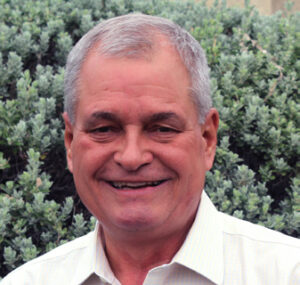Number of employees: 80
Size of service area in acres: 90,640
Amount of water diverted for irrigation per year in acre-feet: 282,098 (2010); 57,707 (2021)
Main crops irrigated: Alfalfa, chiles, cotton, onions, pecans
Predominant irrigation methods: Flood, drip
Patrick Sullivan
Treasurer-Manager
Elephant Butte Irrigation District
Las Cruces, NM
Irrigation Leader: How many vehicles and pieces of equipment does your district own?
Patrick Sullivan: We own 69 pieces of heavy equipment, including everything from single-axle dump trucks to motor graders and excavators. We also have 82 pickups and service trucks.
The majority of our heavy equipment was built after the year 2000, but we do have an aging fleet, primarily because of the costs of replacing items like large excavators and motor graders. We continuously weigh the cost of repairs and maintenance versus replacement, and in today’s economy, it’s hard to find an excavator for less than $300,00–$350,000. We’ve are still using some 1980s models of heavy equipment, such as motor graders. An aging fleet requires more maintenance.
Irrigation Leader: What kind of maintenance is required for your vehicles and equipment?
Patrick Sullivan: We do all maintenance except for body work in house. Our primary maintenance is done at the central yard. We have a full shop and mechanics. Our mechanics can do everything from replacing the carriage on an excavator to oil changes, engine replacements, overhauls, and the rebuilding of hydraulic systems on equipment.
Irrigation Leader: What kinds of records do you keep of that maintenance?
Patrick Sullivan: We track what we spend on each and every item.
Irrigation Leader: Do you have any regular schedule for maintenance on machinery?
Patrick Sullivan: Yes. We have records for our equipment and mileage records for our vehicles. We make every effort to take excellent care of our fleet and to keep up with all the routine maintenance. Our lead mechanic maintains a schedule for all our items. We have two satellite yards: one in Hatch and one in Chamburino. Day-to-day maintenance takes place at those yards. Equipment that requires more-than-routine maintenance is transported back to the central yard.
Irrigation Leader: How do you buy or bid for equipment?
Patrick Sullivan: We do a combination of things. Most importantly, we follow the New Mexico state procurement procedures for new purchases and the New Mexico surplus for used purchases. The state can buy surplus equipment all over the United States, and we have the opportunity to buy some items from it. It’s a matter of being first in line, however, and we have noticed in recent years that many entities are choosing to repair rather than replace. It has become more challenging over the last several years, because people are not trading in much heavy equipment, and when they do, it’s usually past its serviceable life. We used to be able to find equipment with a few hundred hours on it. That is getting harder and harder, especially for big ticket items such as large excavators and motor graders. Replacement costs these days are extremely high.
Irrigation Leader: How long do you use your vehicles and heavy equipment before replacing them?
Patrick Sullivan: We try to make sure that our ditch-rider fleet is in the absolute newest and best condition, because we don’t want breakdowns during the irrigation season. We have historically run those trucks for about 5–7 years before moving them to a different, less critical department. As long as they’re serviceable, we will keep vehicles with over 200,000 miles on them. When things do reach a certain age or when the service requirements reach a certain level, we will auction those items off.
Patrick Sullivan is the treasurer-manager of the Elephant Butte Irrigation District. He can be contacted at (575) 993‑2429.

